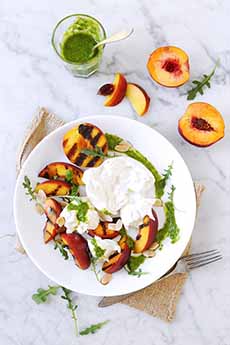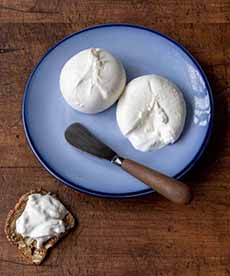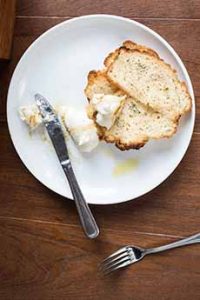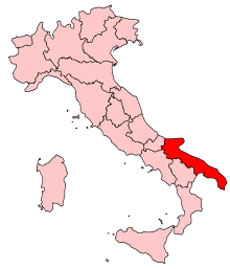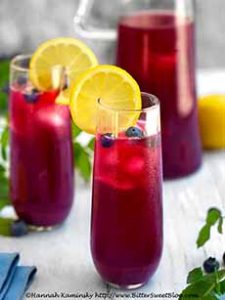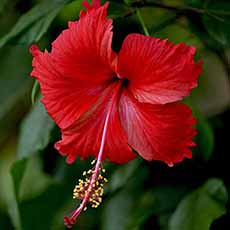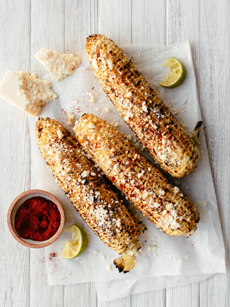|
If you like mozzarella, ricotta, and fresh, creamy cheeses in general, burrata is a treat waiting for you.
Burrata is a fresh Italian cheese, subtly creamy and luscious.
A hollow ball of buffalo mozzarella (mozzarella di bufala) is filled with panna, a cream that contains scraps of mozzarella left over from mozzarella-making.
The cream is thick, like a very fine-grained ricotta.
Burrata means “buttery” in Italian. When you cut into it, the cream oozes out (photo #2).
Made in the Puglia region of Italy (photo #4), burrata was, until relatively recently, only available when in major cities on the East Coast of the U.S.
It was flown in and scooped up by aficionados.
Today, America’s artisan cheese makers are meeting the demand (more about that below) of burrata lovers.
HOW TO ENJOY BURRATA
Burrata is one of those treats that can be served for breakfast with toast (photo #3), with lunch, or with dinner.
Or, serve it when you kick back with a glass of wine, perhaps with these crostini recipes).
The simplest way to serve burrata is on a plate with some crusty bread, sliced heirloom tomatoes, fresh basil, and a drizzle of fine olive oil. It’s a variation of Caprese Salad.
Just as easy: Place a burrata half or quarter atop a green salad, a fruit salad, or a bowl of pasta.
Some recipes:
Burrata & Fruit Dessert
Burrata, Plum & Pepita Salad
Burrata Serving Suggestions
Crostini With Burrata
Grilled Grapes & Burrata For A Cheese Course
Prosciutto Salad With Frisée & Burrata
Spaghetti Caprese With Burrata
Plus today’s recipe, below: Grilled Peaches With Burrata.
THE HISTORY OF BURRATA
We have no idea of the exact origin of most of our foods, such as bread and yogurt.
Historians deduce how they began, and there is archaeological evidence, but for many foods, there is no historic record.
Even the origins of such popular creations as fudge and brownies—which debuted in the U.S. as recently as the 1880s—are lost to history.
But we do know who created burrata, and when.
Many cheeses date back hundreds and even thousands of years. Pecorino Romano was made by the Romans 2,000 years ago, Asiago by Cistercian monks in 1000 C.E. the history of cheese).
But fast forward a millennium: Burrata was first made around 1920 in the town of Andria, about two-thirds of the way up from the heel to the spur of the boot that is the Italian region of Puglia, “the heel of the boot.”
The Bianchini family invented it on their farm. It was a local product and remained the delight of the townspeople only, for thirty years.
In the 1950s, burrata became more widely available in Italy, after a few of the local cheese factories began to produce it. Their interest may have grown because burrata offered a way to utilize the scraps of mozzarella (ritagli, or rags) that were being discarded.
Burrata maintained its artisan status as a premium product, even after it began to be made in a number of factories throughout Puglia.
For years, the only burrata in the U.S. was flown from Italy to New York and other East Coast cities. Because of its short lifespan, it was too fragile to travel further.
Italian-made burrata is traditionally wrapped in a green leaf, the fronds of an Italian plant called asphodel. It’s a plant in the lily family, Liliaceae, which also is the family of asparagus and the different onion genera—chives, garlic, leeks, and onions, among other foods.
The leaves are an indicator of freshness: As long as the leaves are still fresh and green, the cheese within is still fresh. Dried-out leaves mean the burrata is past its prime.
When it travels from the dairy in Italy, burrata is also wrapped in a clear plastic bag to catch the natural liquid that drains from it. In the U.S., a plastic container is typically used.
BURRATA IN THE U.S.
Today, burrata is made at artisan dairies throughout the U.S. Check for it at the best cheese counter near you. We get ours at Trader Vics’; it’s also available online from Murray’s Cheese and other e-tailers.
Cut into the ball and the cream oozes out. While both buttery and creamy, it is not overly rich—just overly delicious.
|
